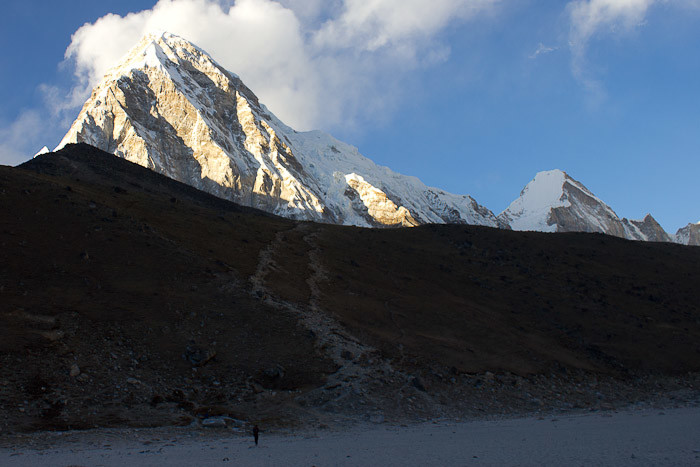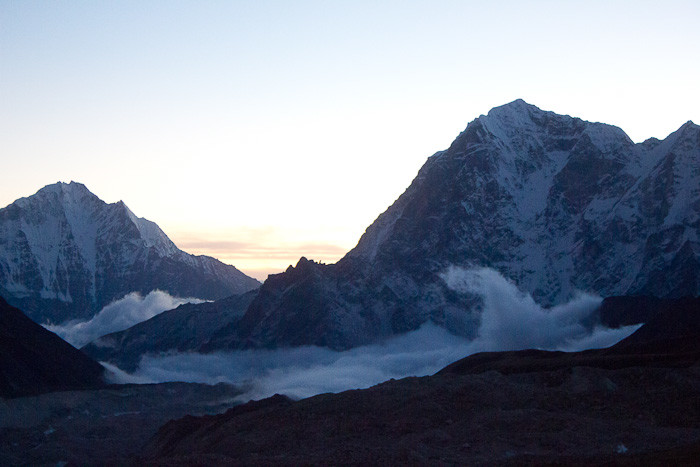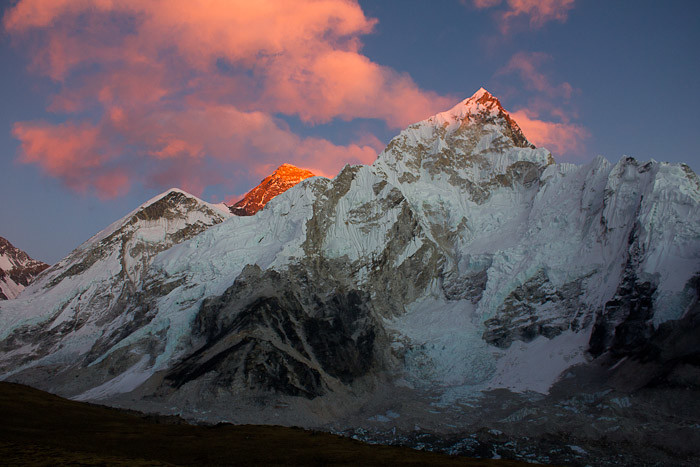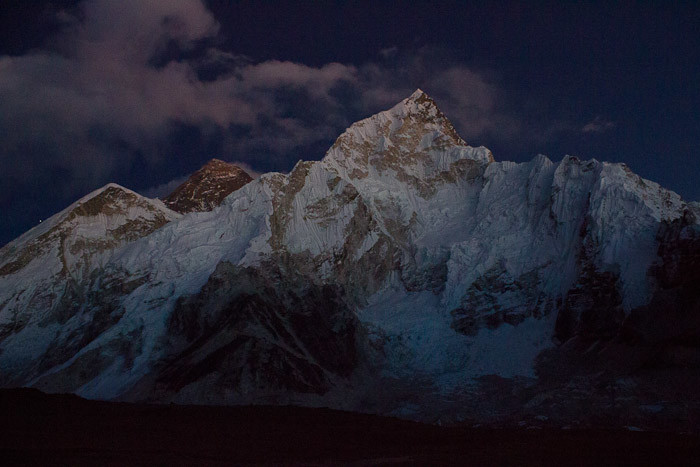Kala Patthar
Everest Base Camp the Lazy Way – Day 14-15
By mid-afternoon, the sun is breaking through the clouds, warming the air both inside and outside our lodge, and I’m beginning to believe we’ll achieve the trifecta of Gokyo Ri, Everest Base Camp and Kala Patthar.
The guys at our lodge say we should set off at 5 to catch the sunset, but that sounds late to Nir and me, so, over protests from my spawn, we don headtorches and layers, and head out into the sunlight.
A black ridge in front of the curving pyramid known as Pumo Ri, Kala Patthar doesn’t look intimidating.
It is, Nir says, easier than Gokyo Ri, or Machermo, let alone the Cho-La, and, as we amble up past the grazing yaks, the gradient is, by Himalayan peak standards, remarkably easy.

Which doesn’t stop Zac complaining, not least because the lodge is now sufficiently close to zero to allow my Mac battery to charge, and therefore some gaming time.
“I’ve already done Everest Base Camp today!” he says, a plea which seems rather less unreasonable with hindsight than it did at the time. “AND I’ve seen Everest LOADS of times. AND it’s an ugly mountain.”
I can’t help notice that it’s getting darker rather faster than it should be doing.
“I don’t care! HURRY UP!” I say. “We’re going to miss the sunset!”
“The sunset,” my spawn observes dourly. “Has started already.”
And, looking south-east down the valley, I can see not only the soupy trail of mist enfolding the mountains, but a tell-tale glow.
Bugger.

In the way of all hills and mountains, though not, I’m pleased to notice, in the manner of Machermo Ri, the peak seems to be getting further away the higher we ascend.
“How much longer?” I ask Nir.
“Forty-five minutes, maybe?” he says.
Bugger, bugger, bugger. “It’s getting dark already!” I say.
I’m unreasonably fixated on getting picture postcard sunset photos from the top of this bloody mountain, and annoyed that time is not on my side.
“Good Everest view here,” says Nir.
I stop and look, properly look.
And it is. It’s dazzling. The alpenglow, a band of red light emitted at sunset and sunrise, has moved over Nuptse to illuminate only Everest, lurking behind the slabby, pyramidal face of Nuptse, and the rocky summit of Nuptse.
My bad temper dissipates, and the three of us, Nir, who’s been with us for most of our waking hours for a fortnight now, Zac and I, sit on the grass and watch.

As the light goes, Nuptse becomes, to my eyes, even more beautiful than it is in the day.
I watch it darkening, fading into night, as three trekkers descend from the summit.
“So, we go to the top?” asks Nir.
“I don’t want to come down this using a headtorch,” says Zac. And he speaks sense. We’ve seen two rescue helicopters come and go already today, whether for altitude or broken limbs I don’t know, and it would be easy to turn an ankle on a stray rock.
But I am torn.
Forty-five minutes more of mildly steep, but, to the acclimatised at least, non-challenging walking will bring us to the top of Kala Patthar, which, at 5545m (18,200 feet), will be the highest thing we’ve climbed, and break the magic 18,000 feet.
But we won’t be able to see anything. And the views are supposed to be stunning.
“OK,” I say. “This is what we’ll do. We’ll head back down, eat dinner, and then Nir and I will get up at 3am, take a look to see how the weather is and whether it’s worth doing sunrise. If it is, we’ll go up it. If not, we’ll go back to bed, wake up at a normal time and head down to Pheriche once the sun’s properly up.”
After some plea bargaining, Zac agrees to a sunrise ascent, weather dependent. I look up at the stars, as plentiful and pristine as they are in the depths of the desert, over open sea or in the jungles of Halmahera. It’s crystal clear.

The alarm on my phone goes at 3am, and, still half-asleep, I shrug on my down jacket, slip my feet into my boots and head outside. Not a single star is visible, and the air has that vinegar sting on the nostrils that comes with approaching snow.
I knock on Nir’s door. “Noooo shnow,” I slur. “Goooo back to bed.”
“I’m coming, Ma’am,” he says.
“Don’t bother,” I say. “No sunrise. No stars.”
I lose the jacket and boots and, hugging my arms close to my body to avoid the worst of my own aroma, dive back into my sleeping bag which is, miraculously, still warm, despite the fact that our water, our moisturiser and even our wet wipes are frozen solid, and pull both quilts over my head.
That’s it, I think. Game over. Oh well. I’m not going to get up to climb the bloody thing if I can’t see anything.
At least, because we walked up the Gokyo Valley, rather than by the busier and easier direct route, we won’t completely be retracing our footsteps.
But, as I snuggle up and drop off to sleep, I can’t help wishing that I could just call a taxi to take us off the mountains. Or make like a Sherpa and head to Namche Bazar in one day, Lukla on day two.
I think about the metropolitan delights of Kathmandu. There will be laundry! Bacon! Blue steak! And, surely, there has to be somewhere with a Negroni?
You can read the last post in this series on our Everest Base Camp trek here, start from the beginning here, or read the next post here.
If you’re thinking of doing the Everest Base Camp trek, I recommend my Everest Base Camp FAQs.

Hey Theodora, Why did you choose to do this trek in early January? Peak winter , I would imagine…Wouldn’t it be more manageable in summer months?
Rahul
Hi Rahul!
Thanks for your comment. I originally planned to do it in early November but I got sick, so we didn’t leave until the end of November. We did most of it in December, which was actually a good time of year to do it, but I’m behind on my blogging as the internet was patchy up there, to say the least, and I can’t drop the narrative part way through, so I need to continue the story.
In summer, FYI, most of the passes become uncrossable, because the monsoon blows in in mid-May, and precipitation falls as snow at height. Peak times are September-November and March-May. I’m very glad we didn’t do it in October, when there are huge numbers of visitors — or, for that matter in November, which also was busy, even at the end.
Cheers,
Theodora
Great picture from Kalar Pattar
Still wish we’d made the top, though. Gah!
Hi Theodora,
It was wonderful to read your blog which reminded our Gokyo & EBC trek back in Oct 2010.
I must give you credit for taking your 12yrs son to your journey. Did he really appreciate the whole thing and why people take up lung busting journey? My daughter joined me to fulfil my dream. She was 22yrs when we went. We still talk about our trekking. Did you not do your research about weather during Dec/Jan when the weather is almost always gloomy and poor visibility. We were unable to do Chola pass due to heavy snow. I have loved reading Chola crossing section.
If you can then read my blog:
http://sksur.blogspot.co.uk/
Regards
Sudip
Hi Sudip, Yes, he loved it, and is still super-proud he did it: we talk about it often. Apart from the Cho-La, which was tough, it was less lung-busting than I’d expected (although we’d done Kinabalu when he was nine, so I knew we could both handle altitude). As regards timing, yes, I knew the weather would be poor: we were actually planning to leave earlier in November, which is a good time to do it as the trails aren’t too busy but the weather is better, but I got a flu bug in Pokhara, so we didn’t start until late Nov rather than earlier in the month. Seemed better to wait for the flu to clear rather than try and trek at altitude with a sore throat and lethargy – that really would have been lung-busting! Cheers, Theodora